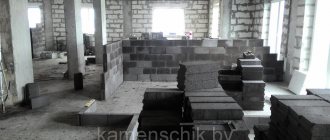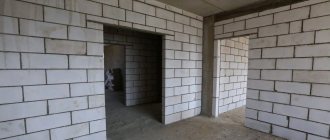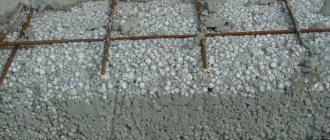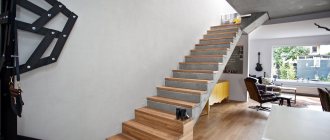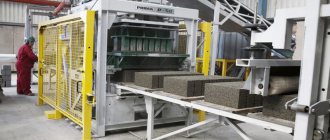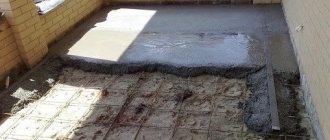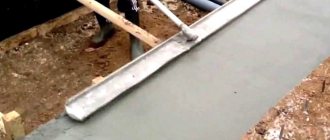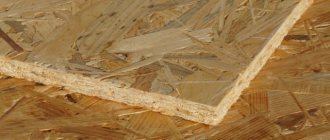Today there is a wide variety of materials from which durable and high-quality partitions can be built. Each of them has its own advantages and disadvantages, which naturally affects the comfort of living inside a structure built from it.
The cheapest method is the construction of partitions from expanded clay concrete blocks, while their cost is significantly less compared to foam block and gypsum block.
The photo shows the most common materials from which masonry elements of almost any overall size can be produced, and they will all have much less weight than the same brick. In addition, when using volumetric blocks, the consumption of mortar for their installation is significantly reduced. Today, one of the most popular materials that meet all modern requirements for both environmental friendliness and efficiency is the expanded clay concrete wall block.
What are the advantages of expanded clay concrete
Partitions made from expanded clay concrete hollow blocks have a number of advantages related to the characteristics of the material from which they are made:
- This material is noticeably lighter than concrete (has a lower volumetric weight), which greatly facilitates the installation of structures based on it.
- In terms of mechanical strength, such blocks are comparable to their concrete counterparts, and are not inferior to them in terms of resistance to cracking.
- The use of expanded clay concrete is justified by its fire resistance (with strong heating, the load-bearing capacity of the products does not decrease).
- Buildings made from such blocks are distinguished by good vapor permeability (the wall of them “breathes” to its entire depth).
Important: Expanded clay concrete has excellent heat-insulating and sound-absorbing properties.
- Products made from it are distinguished by enviable frost resistance and can withstand about 100 cyclic freezing followed by thawing.
- The environmental friendliness and low cost of expanded clay concrete blanks are especially in demand in the construction of residential building structures.
It is also important that hollow expanded clay concrete partition blocks can be made directly on the construction site (for this, simple equipment will need to be installed next to the object being built).
Builders note their good adhesion to most finishing materials, including ceramic tiles, laminated plastic, plaster or natural wood.
Construction Features
Anyone who wants to build a house from expanded clay blocks should know the intricacies of the technology of such masonry.
First, you need to decide on the type of material used. For low-rise construction, structural and thermal insulation blocks (density from 700 to 1200 kg/m3) are optimal. Lighter ones are suitable only for insulation, while heavier ones (structural) are used in multi-story construction.
Secondly, choose the block size wisely. In order for the costs of insulating expanded clay walls to be minimal, their thickness must be at least 40 cm (for central Russia). The most popular size used for load-bearing walls is 190x188x390 mm. For self-supporting partitions, blocks with a thickness of 90-120 mm are purchased.
Thirdly, keep in mind that the foundation for the walls must be strong and deep enough. The depth of the trench is chosen based on local soil conditions, but do not dig it shallower than 1.0 -1.2 meters. A sand cushion compacted with a tamper (20 cm thick) under the foundation is required. In addition, you will have to pour a reinforced concrete belt (15-20 cm), making a frame for it from 4-6 reinforcing bars with a diameter of 16-20 mm. In case of uneven soil settlement, it will protect the foundation and walls from cracks.
Fourthly, it is more economically profitable when the insulation and finishing of a house made of expanded clay blocks are carried out simultaneously. Therefore, you should decide in advance on the cladding material (siding, facing brick, facade plaster, blockhouse) and insulation (basalt or ecowool).
The laying of expanded clay blocks is not fundamentally different from the technology for constructing walls made of block aerated concrete. Here, the seams are also bandaged and the deviation of the wall surface from the vertical is monitored (using a plumb line and level). Horizontal evenness is achieved by installing a mooring cord at the corners, marking the line of the row.
When building from expanded clay concrete blocks, there is one important nuance - the use of insulating jute tape. It is laid in the middle of the masonry, thereby cutting off access to the cold through the solution into the premises.
You can save money by abandoning this decision, but in this case, heat will escape from the house through thick masonry joints (12-15 mm).
Another significant aspect of the technology is the reinforcement of masonry. It should be done in 3-4 rows, placing two reinforcement bars with a diameter of 12 - 14 mm in special grooves on the block.
Scheme of reinforcement of masonry made of expanded clay blocksDespite the fact that expanded clay concrete is stronger than aerated concrete, for the installation of floor panels, a monolithic reinforced belt will also have to be made for it. It will distribute the load from the slabs and prevent them from pushing through individual sections of the walls. From the outside, cold reinforced concrete must be insulated using foam inserts 5 cm thick.
As we have already said, laying expanded clay concrete stone is not too complicated, so not only a professional builder, but also any careful beginner can do it if desired. The main condition for quality when working independently is a careful study of the orders (block layout diagrams) and the use of control tools - a plumb line, a level and a mooring cord.
Since the blocks are quite large in size, it is not difficult to lay them out in an even row. The holes made in them increase the accuracy of splitting with a hammer when it is necessary to make a “half” or “three-four” for ligating seams.
Expanded clay concrete blocks drill well and hold fasteners and plaster perfectly. Therefore, installing a ventilated facade on them, finishing with decorative mortar, plasterboard and other sheet materials is not particularly difficult.
Having ordered a detailed project of such a house, most home craftsmen will be able to remove the masonry with their own hands.
Speaking about reviews from people living in buildings made of expanded clay blocks, it should be noted that most of them are positive. Most often, owners note the good heat-saving qualities of the material, its strength and comfortable microclimate in the premises (subject to competently executed masonry and finishing).
Types of expanded clay concrete blocks
Blocks for partitions made of expanded clay concrete are usually classified according to the following parameters:
- by density, which determines the load-bearing capacity of the product;
- by appointment;
- according to the shape and structure of the material
The simplicity of manufacturing expanded clay concrete blocks allows you to set parameters based on the purpose of each specific type of product. When considering partitions, the shape and size of the block are especially important.
In accordance with these parameters, a simple expanded clay concrete partition block can have the following designs:
- Pozogrebnevy.
- Straight.
- L-shaped (angular).
- Simple.
In addition, the blocks can be solid or hollow, and also designed in the form of lintels and crossbars. A large selection of shapes and sizes of these products allows you to assemble partitions of any complexity from them.
According to their purpose, they can be wall or partition, ventilation and foundation (their scope is determined by the name of the product).
Purchase of materials and calculation of raw materials
In order to rationally spend the prepared funds, it is necessary to take care of the house design in advance.
In order to rationally spend the prepared funds, it is necessary to take care of the house design in advance. It is better if it is drawn up by an experienced architect, taking into account the properties of the soil on the site and the climatic conditions on it. As a last resort, you can purchase or use one of the standard projects that have already been used for development in the region.
After receiving the project, you can accurately calculate the number of expanded clay concrete blocks needed to build a house. To do this, take into account the following parameters:
- The total length of all external and internal walls;
- Height of the house;
- The thickness of the blocks in the masonry (in one or two rows).
Calculations are carried out as follows:
- First, sum up all the lengths of all walls and partitions.
- After this, the length is multiplied by the height.
- And in the end, they multiply the resulting value by the thickness of one block (or one wall).
- We get the volume of material in m3.
When purchasing expanded clay concrete blocks, you should pay attention to the following aspects:
Step-by-step instructions for laying expanded clay concrete blocks
- Product quality certificates;
- Quality and evenness of block geometry;
- Density of blocks and their dimensions.
Markings and characteristics
For the production of expanded clay concrete blocks, expanded clay and Portland cement are used, processed using the well-known pressing method on a vibrating table. In accordance with GOST 6133-99,10180-90 and 12730.1-78, according to their mechanical characteristics, they belong to the class of lightweight concrete.
According to this document, the following markings are used to designate them:
- Wall products are designated by the symbol “C”.
- The blocks from which hollow partitions are made are marked with the letter “P”.
- Front and ordinary (used for finishing) - “L” and “R”, respectively.
- Corner block blanks are designated as “UG”.
The key technical parameters of these products also include the density of the material, marked as “D”. This indicator for most types of expanded clay concrete blocks is in the range from D500 to D900.
The products included in this range differ not only in their density, but also in their thermal conductivity and weight. For example: with the dimensions of an expanded clay block of 390x190x180 mm with a density of D500, it weighs approximately 12 kg, and a product with a density of D900 weighs about 17 kg.
Expanded clay concrete blocks can reach 40 cm in length (with a width of about 19 and a height of about 20 cm).
Technical qualities and requirements
The characteristics of the requirements for partition blocks made of expanded clay concrete do not differ from the requirements for standard products, since they are produced according to the same GOST. The technical characteristics of the material are as follows :
- The total volume of 1 block is 0.028 m3.
- Strength – 25-150 kg/cm2 (B3.5–B20).
- Thermal conductivity – 0.15-0.45 W/m2.
- Density – 500-1800 kg/m3.
- Frost resistance – 50-200 cycles.
- The weight of the wall (1m2) will be 500-900 kg.
- Water permeability – from 51%.
According to their characteristics, partition products are considered environmentally friendly, vapor-permeable, durable, fire-resistant, easy to lay, process and interact with various solutions and finishing materials.
In addition, the material does not crack if the correct installation technology is followed, adheres well to waterproofing materials (for example, roofing felt), is not susceptible to fungi and mold, and does not form dampness.
The performance of the blocks may vary depending on the shape used (the presence of hollowness and cracks), here the weight of one product will be different. Dimensions (length, width, height) may also vary.
This can be clearly seen in the table in the photo below, which shows the typical sizes of expanded clay partition blocks from some popular manufacturers:
The excellent quality of the presented expanded clay concrete products is that they do not shrink, with high-quality arrangement of a strip or monolithic foundation.
Installation of a partition made of expanded clay blocks
Mortar for expanded clay concrete
For laying expanded clay concrete blocks, either purchased powder mixtures or solutions prepared independently before starting work are used. In the first case, when mixing them, you should follow the instructions given on the packaging.
Please note: A concrete mixer located close to the place where the partitions are laid is best suited for these purposes.
The basis of home-made solutions is cement of the highest grade (not lower than M400), to which sand, cleared of lumps and debris, is added in the required proportion. The choice of the ratio of components in the solution depends on the required strength of the masonry (under normal conditions it is selected 1 to 3).
The cold water used in the mixture is pre-filtered (cleansed of large particles of debris) before use. Its content in the finished mixture should not exceed 25 percent of the total mass.
When preparing the solution yourself, experts advise adhering to the following rules:
- The composition is prepared immediately before use (due to the possibility of it hardening).
- To do this, it is more convenient to use a small volume concrete mixer.
- First, a little water is poured into it, and then the amount of sand and concrete calculated for one batch is poured.
After the composition is thoroughly mixed, the remaining portion of water is added to it.
Preparing the base
Before laying expanded clay concrete partition blocks, a base is prepared, which means a waterproofing layer laid over concrete. For these purposes the following can be used:
- ordinary roofing felt;
- stekloizol;
- any other laid roll material.
Before laying the insulation, the work area should be cleared of debris and remnants of the old coating, and then leveled with a layer of screed. After this, a layer of cement mortar is applied to the concrete, on top of which waterproofing is laid.
If it is necessary to equip a base for a partition, bricks or FSB are used as a base.
How to lay expanded clay blocks correctly
Before starting installation, you should prepare a set of blanks of already adjusted size and place them next to the work site. After this, you will need to choose a masonry scheme: half or one block (when constructing partitions, the second option is usually used).
The technology for laying expanded clay concrete blanks involves the following sequence of actions:
- First, corner (beacon) blocks are installed.
- Then a string is stretched between them to control the correctness of the masonry.
- After this, be sure to lay the first row of blocks on the mortar (not glue!).
Important! You should start from the highest point of the base, leveling the voids by increasing the width of the gap (seam).
- The second and subsequent rows are laid with a slight offset, and the thickness of the seam should be at least 1 cm.
Upon completion of the next row, it is necessary to check the evenness of the laying, since due to uneven sizes of the blocks it may be disrupted. We should not forget about the reinforcement of the structure, which should be done with a special mesh every 3-4 rows.
Dressing
When installing blocks, first of all you should worry about the connection of the partition with the supporting structures of the building, which is carried out over the entire thickness of the walls. To organize it, holes are drilled into them, into which reinforcing bars are then inserted along with the mortar.
When laying expanded clay concrete partitions and piers, ligation between rows is required, ensured by shifting the blocks in each row by half their length. With a standard size of a typical block blank of 38 cm, this will be approximately 19 cm.
Bandaging allows you to increase the strength of expanded clay concrete structures by distributing the load evenly over their entire area. This method has always been used to reinforce not only light partitions, but also other building structures.
Doorway
When constructing expanded clay concrete partitions, it is necessary to build in door blocks, for the design of which it is advisable to use tongue-and-groove panels. If available, you will need to perform the following operations:
- Securely fasten the side walls, for which a reinforcing rod is used, laid in niches on the sides of the opening.
- Then their sections are filled with a solution, on top of which a pre-prepared metal jumper is laid.
Additional information: For solid expanded clay concrete blanks, reinforcement is not necessary; It’s enough just to align their edges.
For hollow blocks, special jumpers are provided that fit perfectly with them and are hidden in the structure of the pier.
Completion of wall construction
Upon completion of the construction of the expanded clay concrete wall partition, it is not built right up to the ceiling. Between the ceiling and the top row of blocks it is necessary to leave a gap of about 1-1.5 cm (this gap is subsequently filled with polyurethane foam).
The working gap is necessary in order to prevent deformation of expanded clay concrete partitions due to possible vibrations of the ceilings.
Product Description
Expanded clay concrete product for partitions is an artificially created stone from natural components, by pouring into special molds .
The expanded clay concrete block for partitions has a rectangular shape and belongs to the structural and thermal insulation type, which helps to divide the building area into design zones (rooms), arrange window and door lintels, and equip utility structures.
The main types used for partitions are solid and hollow gray blocks.
Hollow blocks are considered light in weight and have 4-6 notches inside the stone.
They are convenient because they evenly distribute the load over the surface of the wall, and reinforced rods can be placed in them.
Solid blocks are always used to construct the bottom layer, which is installed directly over two layers of waterproofing layer (bitumen), as well as when laying the topmost layer, which is involved in creating an armored belt under the roof of the room.
Partition blocks have excellent characteristics that allow you to carry out any finishing work with them. The choice of the block used in the masonry - solid or hollow - depends on the load that the interior wall will take on.
Partition products begin to be installed only after work on the load-bearing structural walls of the building is completed.
For their laying, sand-cement mortar of the M400 - M500 brand is used, as well as special types of glue, in the form of a dry mortar or ready-made liquid compositions and foam. GOST regulatory rules for expanded clay concrete, which relate to the partition type :
- 33126-2014 – Expanded clay concrete wall blocks.
- 25820 – Block manufacturing standards.
- 6133-99 – About concrete wall stones.
- TTK – Technology of laying openings with blocks.
These documents regarding expanded clay blocks for arranging partitions are considered basic, but a number of requirements are also additionally established for the composition of the incoming substances of the blocks, which are detailed in paragraph 5 of the technical requirements section in accordance with GOST 33126-2014, with reference to these documents.
Important! Partition blocks help create through holes in walls used for arranging communications, gas, and ventilation ducts.
Mortar or glue
When considering special compositions and mixtures used for laying blocks, you need to pay attention to the following:
- When working with most expanded clay concrete materials, preference is given to special adhesive compositions.
- When laying the first row of blocks, it is best to use cement mortar.
- A special mixture used for laying tiles can be used as glue.
It is important to note that when using an adhesive composition, the quality of installation of expanded clay concrete products only increases.
Advantages and disadvantages
The advantages of using expanded clay blocks for the construction of partitions are as follows:
- A simple technology for laying blocks using half-blocks.
- Ease of simultaneous use with reinforced materials, thanks to the hollow sections.
- Environmental friendliness and durability of the product composition.
- Light weight (less than a brick, but more voluminous) and the possibility of installation using glue or sand-cement mortar.
- Strength, density, high sound and noise insulation qualities.
- Qualitative characteristics of expanded clay concrete, allowing you to save on insulation due to the low level of thermal conductivity.
- Creating a good climate thanks to the natural “breathable” layer of the wall.
- Fire resistance (resistance to fire).
- Good adhesion of blocks to each other and the possibility of any finishing.
- The ability to withstand various suspended objects equipped with fasteners.
- No shrinkage with a properly made foundation.
- Possibility of use in various climatic conditions and at any levels of seismicity.
- Favorable price (25-30 rubles per 1 piece).
Cons are considered:
- Partition blocks (marked “P”) are not suitable for load-bearing walls and foundation construction.
- Suitable only for low-rise buildings.
- It can only be cut using an electric saw or grinder with a special attachment.
Based on the listed pros and cons, it becomes clear that expanded clay concrete partition products are a profitable and effective purchase in construction.
Monolithic partitions
Monolithic expanded clay concrete partitions are made using standard technology, according to which the pre-prepared mixture is poured into a mold made of special formwork. To obtain the required quality of the external and internal surface, metal fences are added on both sides.
This type of expanded clay concrete products has both disadvantages and certain advantages. Their disadvantage is that production requires bulky formwork, labor-intensive to manufacture and requiring a large number of one-time operations.
Their advantages include the ability to set arbitrary shapes and dimensions during manufacturing that correspond to the structure being built. In addition, monolithic partitions are more durable (compared to a structure made from single blocks).
Please note: To increase the strength characteristics of expanded clay concrete products, their additional reinforcement using known methods is allowed.
Despite all the listed advantages, these types of partitions are used extremely rarely in practice.
What is expanded clay concrete and its advantages
Expanded clay granules used as filler
This is one of the varieties of lightweight concrete. The coarse aggregate in it is not natural gravel or heavy crushed stone, but expanded clay. It is produced by firing clay and shale in rotary kilns. The result is round granules similar to gravel with voids inside.
The pores provide excellent noise and sound insulation:
- air is a poor conductor of thermal energy, expanded clay consists of almost 80% of it;
- Also, air pores and ceramics effectively dampen vibrations that arise in them, including sounds.
In addition to the above qualities, the advantages of the material can be considered:
- lower price even than that of gas or foam silicate;
- excellent strength compared to other cellular concretes;
- greater vapor permeability than dense concrete - the material breathes, this improves the microclimate of the premises;
- high moisture resistance – expanded clay concrete, like any other material based on Portland cement, only gains additional strength at high humidity;
- the material is not flammable;
- during operation and heating they do not emit substances harmful to health;
- smooth surface that lends itself well to plastering and other finishing;
- resistance to cracking.
Here are the characteristics of this material:
| Characteristic name | Unit | Range of values |
| Strength | MPa | 5-15 |
| Density | Kg/m3 | 600-1800 |
| Frost resistance class (the number of freeze-thaw cycles with complete saturation with water that the material can withstand without loss of strength) | F | 25-300 (for materials intended for laying interior partitions, not standardized) |
| Dry thermal conductivity coefficient | 0,66-0,14 | |
| Thermal conductivity coefficient at operating humidity | 0,8-0,17 | |
| Vapor permeability | 0,09-0,3 | |
| The time that a material can withstand exposure to open fire without losing strength | h | 7-10 |
| Fire safety category | — | A1 |
Expanded clay concrete is easy to make with your own hands. Although many people also make foam or aerated concrete on their own, the technology of this material is simpler.
To prepare it, you do not need special equipment or components to form foam or gas pores. It is made in exactly the same way as the usual heavy concrete - just expanded clay is added instead of crushed stone.
Tongue-and-groove wall panels
In construction practice, in the manufacture of expanded clay concrete partitions, tongue-and-groove panels are increasingly used, which significantly facilitate the installation of structures and reduce the consumption of mortar (glue). One such panel with a height of 2.5 meters is equal in area to approximately 20 medium-sized blocks.
Therefore, it will be very difficult for one person to cope with them (an assistant will be required). Due to the large area covered by one panel, the speed of assembly operations increases significantly. At the same time, the quality of the finished partition does not suffer at all, and in any case remains high.
In conclusion, we note that the production of expanded clay concrete blocks has been mastered in many cities of Russia (including several enterprises located in Moscow). Anyone wishing to get acquainted with the prices of expanded clay concrete products can contact the website of the organization selling them.
Main nuances
In order for the construction of a wall made of expanded clay concrete blocks to be strong and reliable, it is necessary to adhere to certain masonry rules. Let's consider building a wall from blocks measuring 9*190*188 mm. To build partitions, blocks of 390*190*90 mm are used.
Execution sequence:
Using a new block, smooth out the applied layer of mortar to obtain a uniform coating. Punch the expanded clay concrete to the edge of the block already laid in this row. Leave a gap of about 5 cm between the blocks. Attach this block to the place where it should be located so that the vertical seam collects a little mortar. It is recommended that the thickness of the seam does not exceed 10 mm. Without waiting for the solution to harden, create a seam.
There are several types of special seams: embroidered convex, embroidered concave, undercut, empty. At the end of the laying process, regardless of the method you used, you need to fill the armored belt. This is a reinforced concrete structure, the task of which is to perform the function of a rafter system. The armored belt prevents the walls from collapsing under the constant pressure of the roof.
Laying walls from expanded clay concrete blocks: technology, features, methods
- 3.67 / 5 5 1 / 52 / 53 / 54 / 55 / 5
Expanded clay concrete is one of the types of concrete, widely used in modern construction (filling the frame of monolithic reinforced concrete houses, in the construction of cottages, garages and outbuildings). The composition includes cement, expanded clay, construction sand and water.
This is not only quite light, but very durable material. The use of expanded clay concrete for walls allows you to save on thermal insulation, as it itself has high thermal insulation properties. Also, taking into account the fact that the dimensions of expanded clay concrete are larger than bricks, the thickness of the wall made of expanded clay concrete blocks will accordingly be greater.
The material has many advantages:
Has high strength indicators. The composition includes cement of a grade not lower than M-400; High thermal insulation. Retains heat much better than ordinary concrete.; Sound insulation.
Due to its structure, expanded clay concrete has good sound insulation, unlike lightweight concrete; High stability. It has amazing resistance to both natural irritants (snow, rain, etc.) and chemicals (sulfate solutions, caustic alkalis); High level of water resistance; Allows you to maintain the required level of moisture in the room;
Not fussy in finishing. There is no need to carry out preliminary work before finishing.
Finishing of expanded clay concrete is possible with any finishing materials. Does not require a thick layer of plaster and installation of reinforced mesh; High resistance to temperature changes and frost; The material does not contain chemicals that aggressively affect the metal structures of the house; Construction of walls occurs very quickly, due to the fact that expanded clay concrete is large in size . The ease of installation will allow a person who has never been interested in construction to build a building using expanded clay concrete; Walls made of this material are relatively light in weight; Does not burn, does not rot, or rust.
Expanded clay concrete, like any other building material, has its disadvantages:
- Having porosity in its form, expanded clay concrete is inferior in strength and mechanical properties to heavy concrete; It is not used to create a foundation; Convexities give an unsightly appearance; Good frost resistance is also a disadvantage. Water trapped in the pores freezes at low temperatures, and ice is known to expand. After several cycles of freezing and thawing, frost resistance may decrease.
Stages of construction of expanded clay concrete walls
The technology for laying expanded clay concrete material is not complicated; you can easily do it yourself.
Below you will find step-by-step video instructions that will make the whole process even clearer.
Video:
Expanded clay concrete blocks are placed on a cement-sand mortar, the thickness of which should be at least 1 cm.
It is necessary to provide space for the seam (thickness from 1 to 5 mm), so do not use glue in the work - it will not be suitable for such a highly porous material as expanded clay concrete.
The method of installing the material is similar and does not depend on whether your block is hollow or filled inside.
To lay the material yourself you will need the following tools:
- shovel (one or more);
- container where you will prepare the solution;
- jointing;
- trowel and trowel;
- level;
- roulette;
- rubber mallet;
- plumb line;
- reinforcing mesh.
You can purchase a ready-made mortar, which is necessary for laying expanded clay concrete blocks, or make it yourself. You need to mix in the following proportion: cement (1 part): sand (3 parts) + 30% water.
Reinforcement of expanded clay concrete structures is a necessary step.
Reinforcement must be carried out according to the following requirements: you can use a standard mesh, reinforcement rods or fiberglass reinforcement, the structure is installed every 4-6 rows.
The video shows a method for laying expanded clay concrete blocks.
Video:
If you choose fiberglass, then keep in mind that an armored belt made of this material does not stretch well, and it is better not to use it if your structure involves 2 or more floors.
Reinforcement in the form of a belt of material is created slightly below the reinforced concrete or brick roof; there is no need to make it low.
Load-bearing and partition walls must be erected at the same time. After construction, it is necessary to coat the horizontal and vertical seams with mortar or foam glue.
Block laying. Features of masonry
Expanded clay blocks are characterized by a specific structure that makes them look like a children's construction set.
And although the material is larger in size than bricks, its weight is much less, which ensures maximum convenience and speed of masonry work. They build a wall, moving from the corner and building the first row in advance. In this case, the internal partitions are built together with the external ones, and in order to prevent the appearance of cold bridges, the end of the structure is separated by a rectangle of polystyrene foam. This action is carried out only for external wall structures. Upon completion of laying the first row, you need to check the evenness of the surface again. To do this, you can use a building level.
Beginning builders and home craftsmen often simplify their task by looking for various step-by-step instructions and tips for laying expanded clay blocks. And if we are talking about installing the second row using new blocks, the solution must be smoothed until a uniform layer is obtained. Then the structure is brought to the edge of the adjacent block with a poke, leaving a gap of five centimeters.
A small amount of cement mortar or adhesive should appear in the vertical joint area. To achieve this, it is enough to place an expanded clay block in the place where it will be installed in the future. Fixation is carried out using a rubber hammer, which helps to align the structures along a horizontal line. The optimal joint thickness is 7 mm for cement mortar and 3 mm for glue.
If the seams are too thick, then the strength of the masonry will be compromised. Conversely, if the thickness is too small, the block will not be securely fastened and will begin to deform over time. Before you continue working, you need to make sure that the seam is done correctly.
It is important to do this before the solution hardens.
Laying schemes, bandaging and joining
Laying expanded clay concrete walls begins at the corners, the blocks are carefully leveled, and the mortar is given time to set.
Then a cord is tied to the corners and the entire row is laid out along it. The last element is usually non-standard and needs to be sawn to size. Note: the height of self-supporting walls should not exceed 3.5 m, and the free length should not exceed 8 m.
Walls can be of different designs, the most common are:
In one row (half a block thick), these are obtained when laying expanded clay concrete blocks in the longitudinal direction. Here there is a classic ligation of the spoon rows with an offset of at least 0.4 from the height of the block (100 mm). In two rows (one block thick), the ligation here is carried out by shifting the spoon rows relative to each other by at least 100 mm as in the longitudinal direction of the wall and transversely. In this case, it is necessary to do a tie dressing every 2 rows - this is when expanded clay blocks are located across the wall, across its entire thickness.
The connection of internal walls with external ones can be done by tying the masonry or by anchoring blocks, mortgages or reinforcing elements with a pitch of 600 mm (the permissible minimum is two tyings per floor height). All steel products used in dressings must be corrosion-resistant (stainless steel or specially coated).
Reinforcement and lintels
In order to smooth out subsidence and shrinkage deformations of the masonry, as well as reduce the risk of cracking, girdle reinforcement is installed for every third row. For this purpose, when carrying out work on their own, steel rods of periodic profile with a diameter of 8 - 10 mm are more often used.
For them, you need to make a groove of such a depth (up to 25 mm) that the rods are completely immersed there, without sticking out anywhere. The reinforcement should not be interrupted at the corners of the structure; it would be correct to bend it with a certain radius. Next, you should lay the solution in the groove, “drown” the rod in it and cover it on top.
Reinforcement is required in the following support rows:
1. Under door and window openings. In these places it is necessary to place two rows of reinforcement 500 - 900 mm longer than the width of the opening on each side.
2. Under the ceiling. Here, around the perimeter of the walls, encircling double-row reinforcement or frame reinforcement is installed, laid in U-shaped blocks.
If the masonry is carried out independently, without a preliminary design and calculations, then, giving in to the desire to “work better and stronger,” you can make girdle reinforcement every 3 rows, this will increase the crack resistance of the structure as a whole.
Over window and door openings, lintels can be arranged as follows:
Using U-shaped products. To do this, a support formwork is constructed, trays are laid out on it with an overflow of at least 250 mm onto the wall.
A reinforcement cage is placed in them, and everything is filled with concrete, which is compacted by bayonet, then the surface must be leveled using ready-made reinforced concrete lintels. They are laid on a layer of mortar with an overflow of 100 mm for non-load-bearing structures and at least 250 mm for load-bearing structures. You can also use a rolled steel profile (angles, square pipes) as permanent support formwork. You can simply lay expanded clay blocks on top with a regular dressing.
The floor should be supported on a support row with encircling reinforcement, which will evenly redistribute the load along the entire perimeter.
If a reinforced concrete slab or beams are used, it is recommended to anchor the floor to the walls using bent reinforcement rods (for example, Ø8 A240). One side of the bent rod is hooked to the mounting loop of the ceiling, and the other is placed along the expanded clay blocks. It is also advisable to additionally protect the ends of floor slabs in external walls with a layer of insulation.
In cases where you are not confident in your abilities, it is better to turn to specialists. The cost of masonry per cube in the regions of Russia varies from 900 to 1600 rubles, the highest prices are in Moscow. Also, the cost depends on the types of work included in the estimate; for example, loading is sometimes considered separately.
If you want to have a country house, but there is not enough money for construction, for example, the same wood will not work, not to mention brick. In this case, for the installation of the house, masonry walls made of expanded clay concrete blocks can be used, which have high quality characteristics and are not too expensive.
If you build a house with your own hands, you can save another small amount. But for independent installation you need to know the operating algorithm. This article will give step-by-step instructions on how to efficiently lay walls from expanded clay concrete blocks.
Final and external finishing
Insulation options
Scheme of construction of an expanded clay concrete house.
Before cladding, you need to decide on the insulation. The best way is to insulate an expanded clay concrete house using mineral wool. Mineral wool can retain heat well, and if you add a layer of aluminum foil, the house will not be afraid of even severe frosts.
You can choose fiberglass, which is laid on the inside under the drywall, and on the outside - a layer of foam plastic. Expanded polystyrene is not as expensive as mineral wool, and its properties are virtually identical.
- If the inner layer is plaster on the inner surface (without reinforcement), and the size of the load-bearing wall is 450x190x240 mm, then the thermal insulation layer is mineral wool or polystyrene foam (100 mm layer, thermal conductivity - 0.035 W/m degrees Celsius).
- The inner layer is plaster on the inner surface (without reinforcement), and the size of the load-bearing wall is 450x190x240 mm (laying was done in a bandage), then the thermal insulation layer will be mineral wool or polystyrene foam (layer 50 mm, thermal conductivity 0.05 W/ m degrees Celsius).
- Plaster is used as the inner layer on the inner surface (without reinforcement), and the size of the load-bearing wall is 450x300x240 mm, then the thermal insulation layer can be anything. As an option, polystyrene foam chips.
Facade materials
Diagram of the structure of an expanded clay concrete block.
The cladding of a house, which is made of unsightly blocks of expanded clay concrete, will carry not only aesthetic, but also practical functions. The material is able to perfectly withstand the influence of moisture, however, despite this, a sharp temperature change can damage the structure. Expanded clay has the ability to withstand heavy loads, but before cladding it is necessary to strengthen the wall using reinforcement. When the foundation is being built, it is necessary to leave a distance of approximately 1 brick for the future facade.
Brick, cement-sand plaster, natural stone, thermal panels, siding, marble - this is just a small list of what to clad a house with.
The most common method is to make brick cladding, clinker or ceramic. The cheapest way is to perform cladding using cement-sand plaster. Decorative or cement-sand plaster, as well as facade paint, make it possible to create various textured surfaces and a very attractive exterior. Plaster may be suitable for expanded clay concrete because it is used on surfaces that are prone to damage from temperature changes.
Diagram of the heat block design.
When decorating facades, natural stone will look noble and aesthetically pleasing
When choosing a natural stone, you should pay attention to its frost resistance. Artificial stone (brick) will not be inferior to natural stone in its aesthetic and functional properties, but its cost is much less. Finishing facades using thermal panels, which consist of clinker tiles and polyurethane foam, is an economical method of cladding
Thermal panels are lightweight and can be successfully used if the house has a strip foundation. They are environmentally friendly, durable, and thanks to polystyrene foam, they are able to maintain heat during frosts and provide coolness during hot periods. Even a non-professional tiler can handle the installation of thermal panels. Ventilated facades can successfully hide all the imperfections of the walls. Due to the fact that they have an air space between the cladding and the inner wall, they will allow moisture to pass through and prevent its destruction. Siding is one of the cheapest ways to finish building facades. Siding panels can be fragile, and damage during operation can negatively affect the expanded clay concrete wall.
